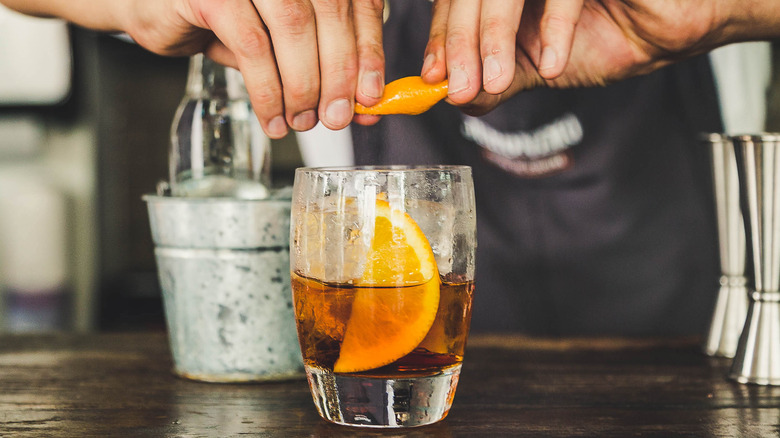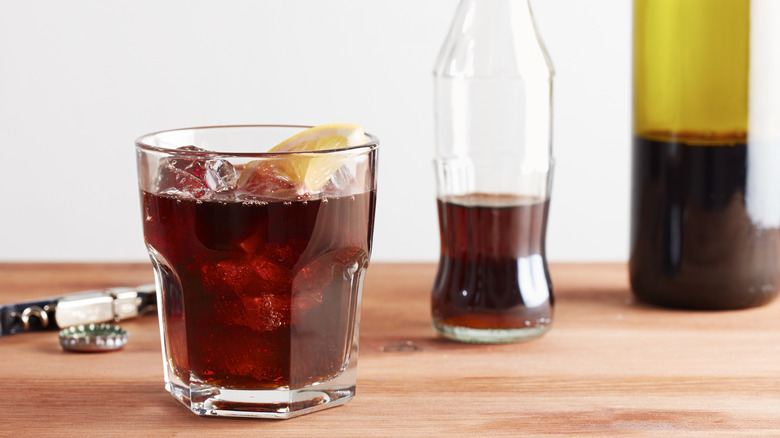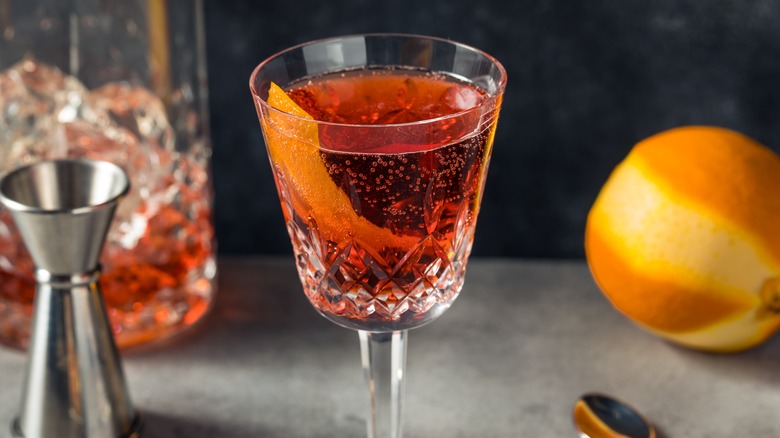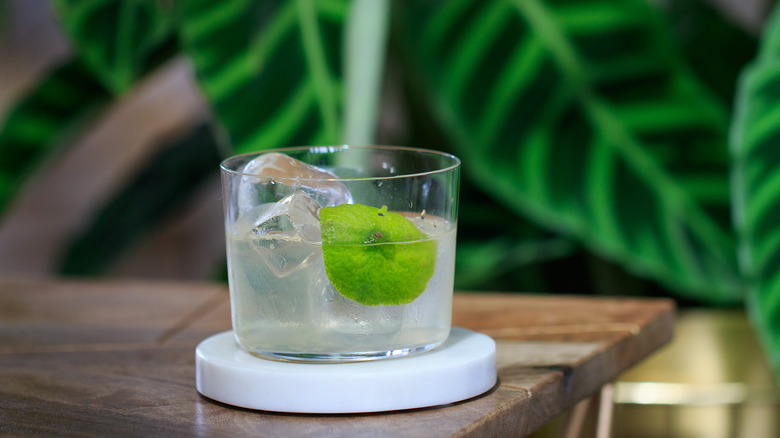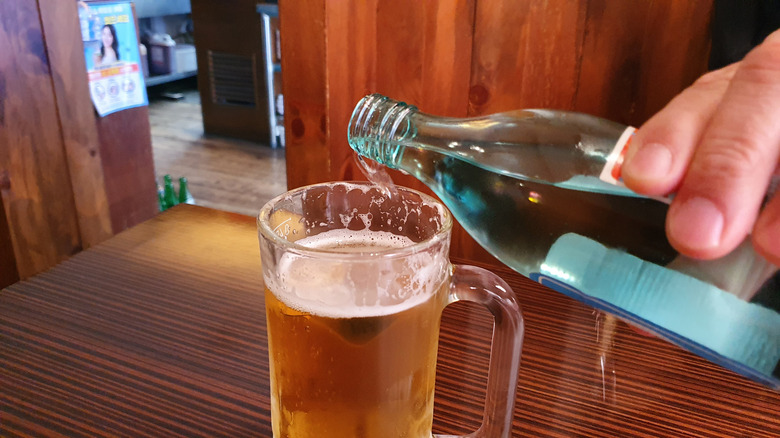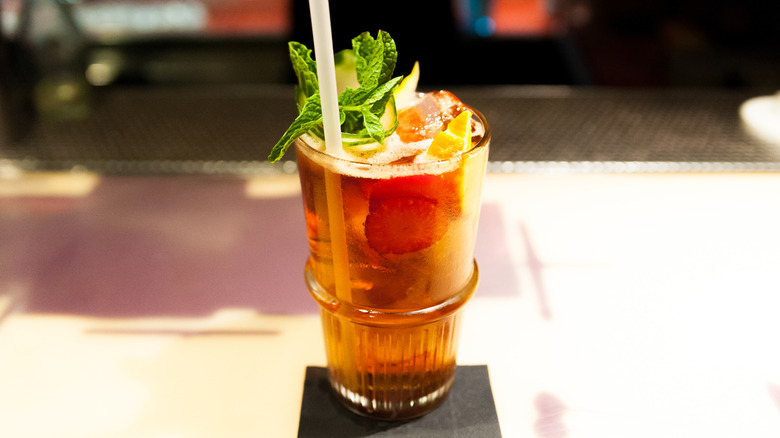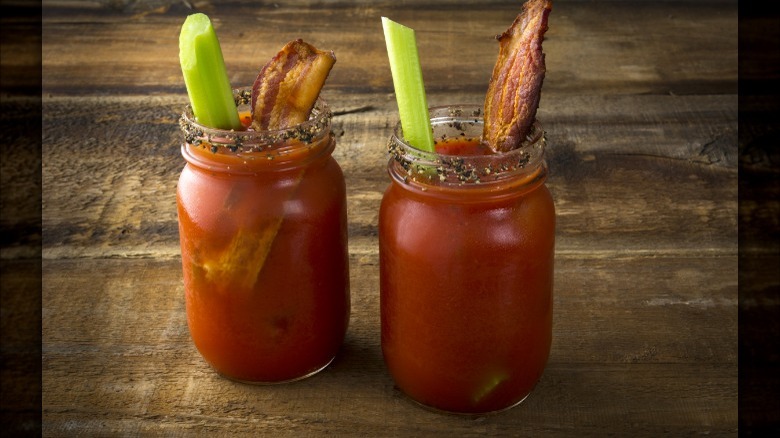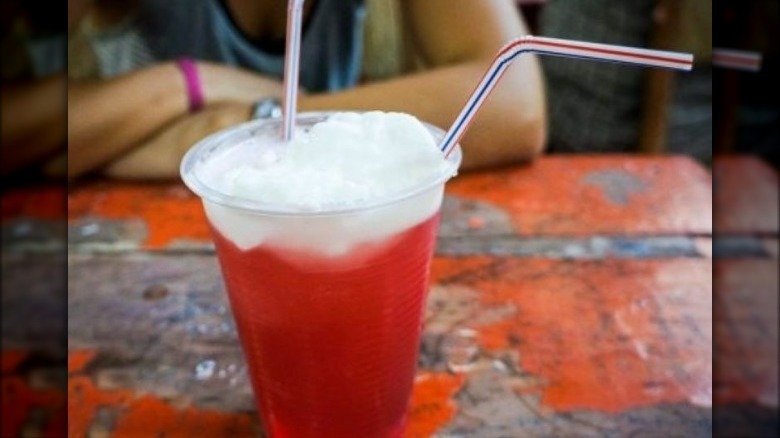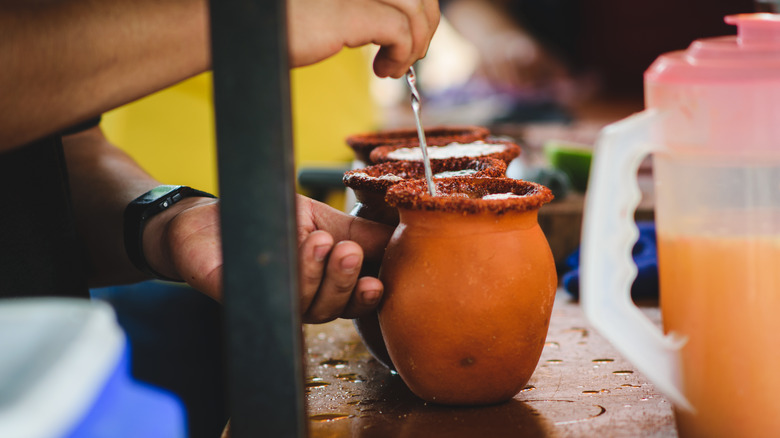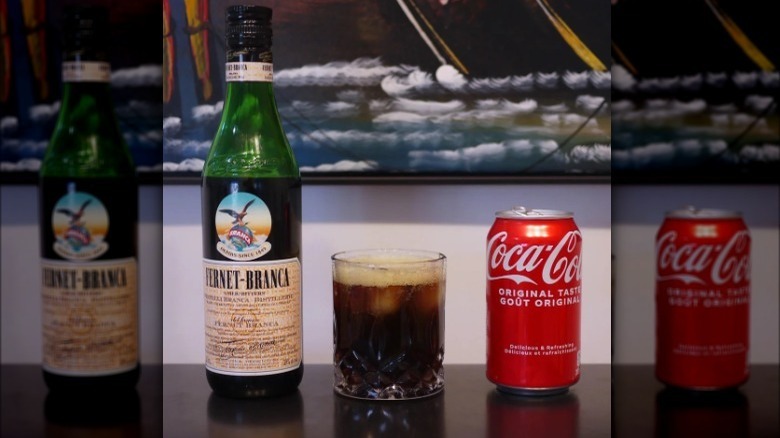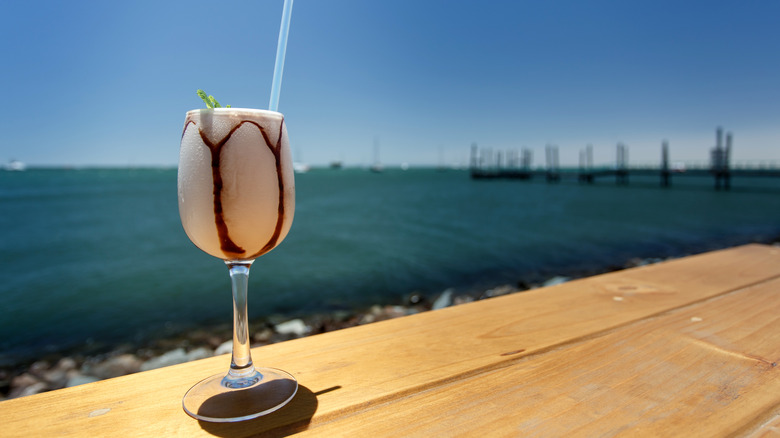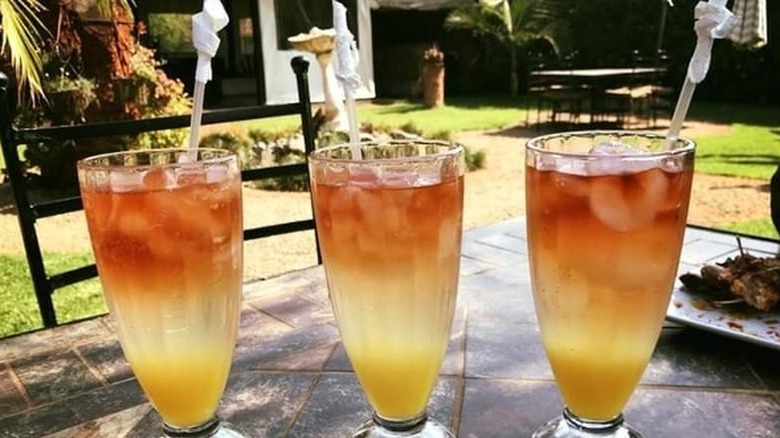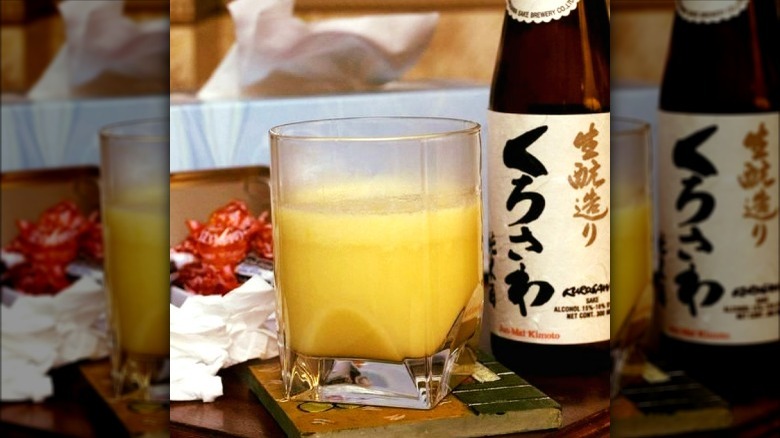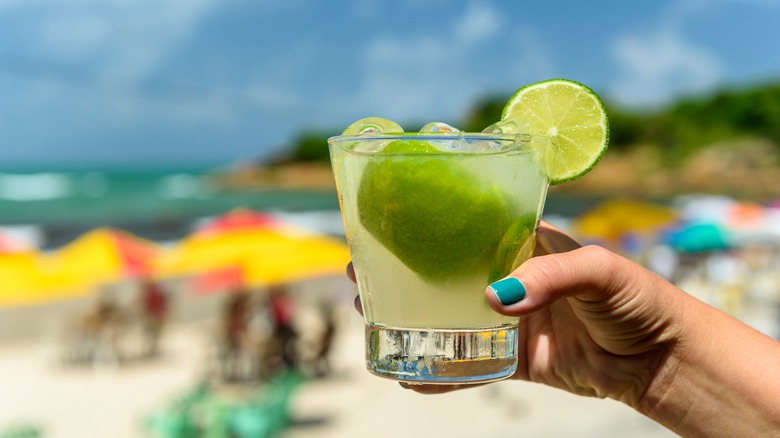13 Lesser-Known Cocktails From Around The World You Should Order
Are you looking to spice up your cocktail repertoire? We've all tried Negronis, martinis, and margaritas, but as much as we love them, there's nothing wrong with craving something new. If you've run out of ideas, however, where do you look for inspiration? Perhaps you search abroad, in the wider world of creative cocktails. Many of the cocktails we already know and love hail from other countries, after all. Sangria is a summertime staple in Spain, and it feels as if Cuban mojitos have been around forever. We've only recently started enjoying Aperol Spritzes in the States, but Italians have been drinking them since the '50s. Realizing this, you just might get to wondering: What other foreign cocktails are we missing out on?
As it turns out, there's a whole world of cocktails to discover. Drinks that are commonplace in other countries might be entirely new to you. Whether you're practicing your bartending skills or just looking to mix things up on a night out, we've got you covered. Keep reading to learn about 13 lesser-known cocktails from around the world.
1. Calimocho (Spain)
Calimocho, or kalimotxo, is a wine cocktail made of equal parts cola and red wine. It's simple and not particularly sophisticated, which is part of its allure. This drink is economical and can make even the cheapest wine palatable — it's no wonder it's a favorite among Spanish youth. In Spain, young adults gather in large plazas to socialize and drink — events locally known as botellónes. Calimocho has been a botellón favorite for decades.
But Spanish youth aren't the only ones enjoying calimochos. This cocktail exists under different names around the world: It's katemba in South Africa, bambus in Croatia, and jote in Chile. It's the perfect gateway drink to enjoying wine, and, weirdly, it tastes exactly like you'd think. You'll notice both flavors, but neither overpowers the other. If anything, cola and wine balance each other well, creating a cocktail that's not too sweet, nor too dry.
The Basque country is credited for inventing the kalimotxo, but this cocktail is gaining traction in the United States. Even if you can't find calimochos in your local bar, it's ridiculously easy to make. Just pour red wine and Coke over ice. Cheap wine is preferred; using higher quality is just an insult to the wine itself. If you really want a taste of the botellón experience (with an American twist), pour that calimocho into a red Solo cup. Salud!
2. Negroni Sbagliato (Italy)
When asked about their favorite drink, "House of the Dragon" star Emma D'Arcy uttered oh-so cheekily, "Negroni sbagliato ... with Prosecco in it." This 10-second video clip became a TikTok sensation, piquing our interest in the process. Perhaps it was D'Arcy's delivery, almost as if they were letting us in on a little secret. We had to know: What exactly is a Negroni sbagliato?
While the classic Negroni is an international favorite, the Negroni sbagliato has somehow stayed under the radar. If you're only just learning about it, you're not alone. The sbagliato replaces gin with Prosecco, resulting in a cocktail worth all the hype. To create this Italian aperitif at home, pour equal parts Campari, vermouth, and sparkling wine into a champagne flute. Garnish it with an orange twist and forgo the ice.
If you like both bubbly and bitter experiences, you'll love the Negroni sbagliato. Beautifully, it's just as easy to make as it is to drink. So, if your local bartender hasn't heard of it, be a bossy bar-goer and clue them in. You'll be doing them a favor by introducing them to this underrated Italian drink. Although sbagliato translates to "wrong" in English, nothing's ever felt more right.
3. Ti' punch (Martinique and Guadeloupe)
Ti' punch is the national drink of the French Caribbean islands of Martinique and Guadeloupe. This punch consists of rhum agricole, lime juice, and sugarcane syrup. It's a strong drink with bright rum flavor, backed by sweet citrus.
Rhum agricole is made from pure sugarcane juice, while other rums are often made from molasses. As such, rhum agricole has a more grassy, earthy flavor. If you can't find rhum agricole, Haitian or Jamaican rum can be substituted. To make this cocktail, squeeze fresh lime juice into a chilled rocks glass. Stir in the sugarcane syrup, followed by the rhum agricole, and add a lime wedge. You can substitute simple syrup for sugarcane syrup, but bear in mind that sugarcane syrup has a thicker consistency and richer flavor. Ice is optional, but it'll melt far too fast if you're in a Caribbean climate.
"Ti'" stems from the Creole word for petite. However, this little beverage packs quite the punch. Locals even use it as a casual pick-me-up throughout the day. If you want a refreshing jolt of island energy, try a ti' punch.
4. Soemak (Korea)
What calimocho is to Spaniards, soemak is to Koreans. The ingredients of this drink are built into its name: soju + maekju (beer) = soemak. There are no strict rules regarding soemak, although 30% soju and 70% beer is the norm. While many soju flavors exist, most Koreans opt for the classic variety and pair it with a light beer or lager.
If you're unfamiliar with soju, it's a clear spirit made of distilled starches (typically rice). The alcohol content varies, but one popular brand, Soonhari Original Soju, stands at 13.8%. Straight soju tastes like a slightly sweet vodka with hints of vanilla — but don't let its lower alcohol content and pleasant flavor fool you. Soju hits hard and fast, and when you least expect it.
This is why soemak is a wonderful way to drink soju. Unlike sake bombs, there's no need to down the drink; It can be enjoyed as slowly or as quickly as you'd like. You'll find soemak at all Korean occasions: picnics, parties, or business dinners. You can pour the soju straight into the glass or drop it in like a shot. And, if you really want to get creative, try the Tamakaze, a layered drink of Coke, soju, and beer.
5. Pimm's Cup (Great Britain)
You can't spend a summer in Great Britain without trying a Pimm's Cup. This British staple consists of Pimm's No. 1, sparkling lemonade, and fresh garnishes. What's great about the Pimm's Cup is that you get a potpourri of flavors: sweet, sour, fruity, and herbal. It's crisp, bubbly, and the perfect light libation for a sunny day.
If you haven't tried it, Pimm's No. 1 is a gin-based liquor infused with herbs and caramelized orange. In the States, it can be found at well-stocked liquor stores and British pubs. While you could technically substitute it with a blend of gin, vermouth, and orange liquor, we wouldn't recommend doing so — nothing quite replaces the real thing.
However, you can get creative with the mixers. Ginger ale, Sprite, or tonic water all make delicious replacements for lemonade. And don't be stingy with those garnishes: Mint, cucumber, strawberries, and oranges are all common. The way we see it, the more, the merrier.
6. Caesar (Canada)
If you're a Bloody Mary fan, meet Caesar, its Canadian cousin. This cocktail is essentially the same, but with a fishy twist. Instead of regular tomato juice, Canadians use Clamato, which is a combination of clam broth and tomato — a duo you probably didn't even know existed. You'll find it in most Canadian grocery stores because, well, Canadians love their Caesars.
Now, when most non-Canadians hear about this cocktail, they might shudder. Don't knock it till you try it. As one Canadian on Reddit put it, "By far the greatest mixed drink ever devised. Simple to make, difficult to perfect. I have spent many nights out in search of the perfect one and have tried many permutations. Have discovered that with the right vodka, real lime, 1/2 tsp of horseradish, and a jumbo shrimp hanging on the glass, it is near perfection."
Moreover, when you're craving the hair of the dog, Caesars hit just right. With a heavy base and oodles of sodium, it's no surprise this drink is touted as a hangover cure. And, if the cocktail doesn't satisfy you, the garnishes will. Caesars are known to be piled high with savory toppings. Go to town with olives, pickles, beans, bacon, shrimp — whatever your heart desires. Because with a Caesar in hand, you'll be happy as a clam.
7. Terremoto (Chile)
If you really want to shake things up, try a terremoto. The terremoto consists of white wine, liquor, and pineapple ice cream. Yes, you heard that correctly. With this combination of ingredients, there's nothing quite like it.
"Terremoto" translates to "earthquake" in English. This cocktail is aptly named: It's sweet, but surprisingly strong. After a couple, you might just feel the ground shaking beneath you. When Anthony Bourdain tried one, he described it thusly: "It's just wine and pineapple, so how come it gets you almost immediately ripped, transported to faraway fields?" He may have gone off on a happy tangent there, but you get the idea.
There's some leniency on the ingredients, but this cocktail must include wine and pineapple ice cream. Many also add grenadine syrup for a lively burst of red color. You can serve it with a dollop of ice cream on top, or mix the sweet treat right into the wine. Sip slowly, since this cocktail gets better as the ice cream melts. It's ideal for humid days and mischievous nights. Additional liquor is optional, and Chileans usually opt for pisco or rum. But be warned — adding booze definitely increases the magnitude of the terremoto.
8. Cantarito (Mexico)
If you like palomas, you'll love the lesser-known cantarito. This Mexican cocktail gives off strong summer vibes, making it a perfect vacation drink. But if staycations are more your thing, it's also easy to make at home.
Its recipe is similar to that of the paloma, but upgraded with a burst of citrus. In Mexico, palomas are typically just tequila and Squirt. The cantarito, on the other hand, adds fresh orange, grapefruit, lemon, and lime juices. It also comes with a salt and Tajin rim and a fresh citrus garnish.
This drink finds its roots in Jalisco, Mexico. Here, they serve the cocktail in clay pots called jarritos de barro. The pots are chilled in cold water and then filled with ice. When you order a cantarito in Mexico, you might be gifted the pot as a souvenir. However, you don't need an original jarrito to make a cantarito — any chilled glass will do. We recommend using freshly squeezed juices and a tequila reposado for the most authentic flavor.
9. Fernet and Cola (Argentina)
Have you tried Fernet? This dark Italian liquor is made from a complex herbal blend. The full ingredient list is kept secret, but we know it includes myrrh, rhubarb, cardamom, and saffron. When sipping it straight, the first flavors to hit your nose are usually menthol and anise. It has an almost medicinal quality, akin to Jägermeister — but with even more intensity.
While you can find Fernet at most liquor stores, it's not super popular in the United States. However, it does have a cult following in bartending communities, particularly in San Francisco. This Bay Area metropolis was responsible for 25% of all U.S. sales in 2008. But nothing beats Argentina's consumption, coming in at a whopping 75% internationally.
With their close ties to Italy, it's no surprise Argentines have commandeered this liquor. But rather than consuming it as a digestif or shot, Argentines mix their Fernet with Coke. The resulting cocktail, nicknamed Fernando or Fernandito, is served in a highball glass over ice. What does it taste like? Some people say it reminds them of toothpaste or cough syrup. While they're not entirely wrong, these descriptions don't do poor Fernando justice. Truthfully, it's much better than you'd think — Argentines love Fernet and Coke for a reason. The drink definitely grows on you. So if you're a bold soul with a pension for herbal cocktails, say cheers to Fernandito.
10. Don Pedro's (South Africa)
Do you have a sweet tooth? Then you'll love this South African dessert. The Don Pedro blends vanilla ice cream, regular cream, and booze until it reaches a milkshake-like consistency. The recipe is flexible, but the shake must be smooth enough to drink through a straw.
As rumor has it, the first Don Pedro dates back to the 1970s. This cocktail was invented by a South African restauranteur named Danny Ferris. When visiting Scotland, he tried whiskey over ice cream and was impressed. He returned home to refine the recipe, and lo and behold, the Don Pedro was born. Although the original recipe calls for whiskey, South Africans experiment with different liquors. Kahlua, Baileys, and Amaretto are all welcome replacements. However, the South African booze of choice is definitely Amarula. This cream liqueur is made from the fruit of the African marula tree. Amarula tastes nutty and fruity with a long cream finish, making it perfect for this milkshake-esque treat.
Since this drink recipe is so easy, we suggest making a whole pitcher's worth. It's a great boozy dessert to share at a barbecue, or as a summertime snack. Just grab ice cream and booze, and start blending. And if you can get your hands on Amarula, we'd highly recommend it. Remember to drizzle each glass with chocolate syrup, top it with shaved chocolate, and add a straw. It's so irresistible, you'll be fighting that brain freeze.
11. Malawian rock shandy (Malawi)
The Malawian rock shandy is popular across all of southern Africa. Rock shandies typically have soda water, sparkling lemonade, and aromatic bitters. But the Malawian version swaps soda water for ginger ale or ginger beer. We'd go for ginger beer to give this cocktail a fiery kick. Overall, this cocktail is just as refreshing as the original, but with a spicy-sweet finish.
Traditionally, the small amount of alcohol in a rock shandy comes from the bitters. If you're looking for a completely non-alcoholic cocktail, simply opt for alcohol-free bitters. If you want something stronger, go for an alcoholic ginger beer, or add a shot of liquor. However, we prefer our Malawian rock shandy precisely as is. Why mess with a good thing, right? There's nothing quite as thirst-quenching as a shandy on a hot summer day. And, with its pretty orange hue, it's a beautiful sundowner that matches the horizon.
12. Tamagozake (Japan)
Tamagozake is Japan's version of eggnog, and the cocktail's ingredients are very straightforward. Broken down, "tamago" means egg, and "zake" stands for sake. It's the delicate art of combining these two elements that makes tamagozake so delicious.
The eggs are beaten until super fluffy, while the sake is heated over a low flame, reaching a simmer. If you want your tamagozake sweet, this is the time to add sugar or honey. When your sweetener is fully dissolved, combine the mixture with the eggs slowly and gradually. It's all about timing, here. If you move too quickly, you'll cook the eggs — and obviously, nobody wants scrambled eggs in their sake.
This Japanese cocktail is sweet on the tongue and warm in the belly. Since it feels healing, it's no wonder the Japanese consider it a health tonic (rather like we would a hot toddy). If you want even more nutritional benefits (along with some spice), grate fresh ginger and cinnamon on top. When served, tamagozake immediately imparts a cozy, festive feeling. It's ideally shared on chilly nights or winter holidays. Gather your friends and raise a glass of egg sake. Kanpai!
13. Caipirinha (Brazil)
It's impossible to enter a Brazilian bar without seeing a caipirinha. This sweet, citrusy cocktail is Brazil's national drink. It has three simple ingredients: cachaça, lemon or lime juice, and sugar. First, muddle several lime (or lemon) wedges with granulated cane sugar. The goal is to expel enough juice from the citrus slices to create a natural mixer. Stir in the cachaça, fill the glass with ice, and voila! You've just made a classic Brazilian beverage.
If you haven't heard of a caipirinha, you probably aren't familiar with cachaça (pronounced ku-shah-suh). This spirit is central to Brazilian culture, much like samba or soccer. Cachaça is a rum-like liquor made from distilled sugarcane juice. With a lively, grassy flavor, it's like a cross between white rum and tequila. You can find cachaça in some liquor stores or bars. If not, a caipiroska is the exact same cocktail made with vodka instead. What with the Japanese influence in Brazil, there are also sakerinha caipirinhas, which replace cachaça with sake.
Is citrus not your thing? Not a problem. While the standard caipirinha is made with lemons or limes, you can use virtually any fruit in its place. Common caipirinha flavors include strawberry, passionfruit, kiwi, or pineapple with mint. It's an easy cocktail with versatile ingredients, so you really have no excuse. Go ahead and get muddled and merry with this Brazilian beverage.
